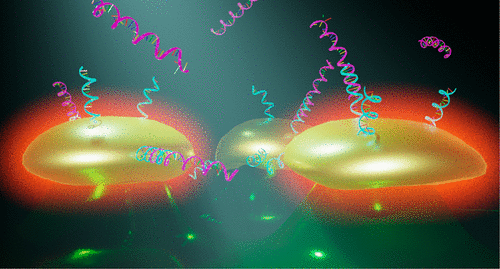当前位置:
X-MOL 学术
›
ACS Appl. Mater. Interfaces
›
论文详情
Our official English website, www.x-mol.net, welcomes your feedback! (Note: you will need to create a separate account there.)
Large Scale Fabrication of Ordered Gold Nanoparticle-Epoxy Surface Nanocomposites and Their Application as Label-Free Plasmonic DNA Biosensors.
ACS Applied Materials & Interfaces ( IF 9.5 ) Pub Date : 2020-01-15 , DOI: 10.1021/acsami.9b20907 Tomáš Lednický 1 , Attila Bonyár 2
ACS Applied Materials & Interfaces ( IF 9.5 ) Pub Date : 2020-01-15 , DOI: 10.1021/acsami.9b20907 Tomáš Lednický 1 , Attila Bonyár 2
Affiliation

|
A robust and scalable technology to fabricate ordered gold nanoparticle arrangements on epoxy substrates is presented. The nanoparticles are synthesized by solid-state dewetting on nanobowled aluminum templates, which are prepared by the selective chemical etching of porous anodic alumina (PAA) grown on an aluminum sheet with controlled anodic oxidation. This flexible fabrication technology provides proper control over the nanoparticle size, shape, and interparticle distance over a large surface area (several cm2), which enables the fine-tuning and optimization of their plasmonic absorption spectra for LSPR and SERS applications between 535 and 625 nm. The nanoparticles are transferred to the surface of epoxy substrates, which are subsequently selectively etched. The resulting nanomushrooms arrangements consist of ordered epoxy nanopillars with flat, disk-shaped nanoparticles on top, and their bulk refractive index sensitivity is between 83 and 108 nm RIU-1. Label-free DNA detection is successfully demonstrated with the sensors by using a 20 base pair long specific DNA sequence from the parasite Giardia lamblia. A red-shift of 6.6 nm in the LSPR absorbance spectrum was detected after the 2 h hybridization with 1 μM target DNA, and the achievable LOD was around 5 nM. The reported plasmonic sensor is one of the first surface AuNP/polymer nanocomposites ever reported for the successful label-free detection of DNA.
中文翻译:

有序金纳米粒子-环氧树脂表面纳米复合材料的大规模制备及其作为无标记的等离激元DNA生物传感器的应用。
提出了一种在环氧基材上制造有序金纳米粒子排列的稳健且可扩展的技术。通过在纳米碗状铝模板上进行固态去湿来合成纳米颗粒,这些模板是通过对铝板上生长的多孔阳极氧化铝(PAA)进行选择性化学刻蚀,并通过受控的阳极氧化来制备的。这项灵活的制造技术可对大表面积(几平方厘米)的纳米颗粒尺寸,形状和颗粒间距离进行适当控制,从而能够针对535和625 nm之间的LSPR和SERS应用对其等离子体吸收光谱进行微调和优化。 。纳米颗粒被转移到环氧基板的表面,随后被选择性地蚀刻。所得的纳米蘑菇排列由有序的环氧纳米柱组成,其顶部具有平坦的盘状纳米颗粒,其体折射率敏感度在83至108 nm RIU-1之间。通过使用来自寄生虫贾第鞭毛虫的20个碱基对的长特异性DNA序列,传感器成功证明了无标记DNA检测。与1μM靶DNA杂交2 h后,在LSPR吸收光谱中检测到6.6 nm的红移,可达到的LOD约为5 nM。报道的等离激元传感器是成功报道的无标记DNA检测的首批表面AuNP /聚合物纳米复合材料之一。通过使用来自寄生虫贾第鞭毛虫的20个碱基对的长特异性DNA序列,传感器成功证明了无标记DNA检测。与1μM靶DNA杂交2 h后,在LSPR吸收光谱中检测到6.6 nm的红移,可达到的LOD约为5 nM。报道的等离激元传感器是成功报道的无标记DNA检测的首批表面AuNP /聚合物纳米复合材料之一。通过使用来自寄生虫贾第鞭毛虫的20个碱基对的长特异性DNA序列,传感器成功证明了无标记DNA检测。与1μM靶DNA杂交2 h后,在LSPR吸收光谱中检测到6.6 nm的红移,可达到的LOD约为5 nM。已报道的等离激元传感器是成功报道的无标记DNA检测成功报道的首批表面AuNP /聚合物纳米复合材料之一。
更新日期:2020-01-16
中文翻译:

有序金纳米粒子-环氧树脂表面纳米复合材料的大规模制备及其作为无标记的等离激元DNA生物传感器的应用。
提出了一种在环氧基材上制造有序金纳米粒子排列的稳健且可扩展的技术。通过在纳米碗状铝模板上进行固态去湿来合成纳米颗粒,这些模板是通过对铝板上生长的多孔阳极氧化铝(PAA)进行选择性化学刻蚀,并通过受控的阳极氧化来制备的。这项灵活的制造技术可对大表面积(几平方厘米)的纳米颗粒尺寸,形状和颗粒间距离进行适当控制,从而能够针对535和625 nm之间的LSPR和SERS应用对其等离子体吸收光谱进行微调和优化。 。纳米颗粒被转移到环氧基板的表面,随后被选择性地蚀刻。所得的纳米蘑菇排列由有序的环氧纳米柱组成,其顶部具有平坦的盘状纳米颗粒,其体折射率敏感度在83至108 nm RIU-1之间。通过使用来自寄生虫贾第鞭毛虫的20个碱基对的长特异性DNA序列,传感器成功证明了无标记DNA检测。与1μM靶DNA杂交2 h后,在LSPR吸收光谱中检测到6.6 nm的红移,可达到的LOD约为5 nM。报道的等离激元传感器是成功报道的无标记DNA检测的首批表面AuNP /聚合物纳米复合材料之一。通过使用来自寄生虫贾第鞭毛虫的20个碱基对的长特异性DNA序列,传感器成功证明了无标记DNA检测。与1μM靶DNA杂交2 h后,在LSPR吸收光谱中检测到6.6 nm的红移,可达到的LOD约为5 nM。报道的等离激元传感器是成功报道的无标记DNA检测的首批表面AuNP /聚合物纳米复合材料之一。通过使用来自寄生虫贾第鞭毛虫的20个碱基对的长特异性DNA序列,传感器成功证明了无标记DNA检测。与1μM靶DNA杂交2 h后,在LSPR吸收光谱中检测到6.6 nm的红移,可达到的LOD约为5 nM。已报道的等离激元传感器是成功报道的无标记DNA检测成功报道的首批表面AuNP /聚合物纳米复合材料之一。


























 京公网安备 11010802027423号
京公网安备 11010802027423号